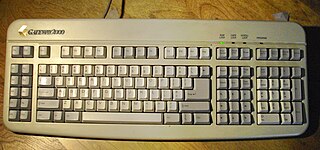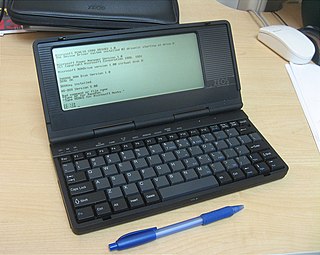
The LTE is a line of notebook-sized laptops manufactured by Compaq Computer Corporation, introduced in 1989 and discontinued in 1997. It was the first notebook computer sold by Compaq and the first commercially successful notebook that was compatible with the IBM PC.

The Gateway AnyKey is a programmable computer keyboard that was sold exclusively by Gateway 2000, Inc., as an option for some of their desktop computers. Introduced in the spring of 1991, the keyboard was manufactured in at least five known versions and incarnations by Tucson, Arizona–based Maxi Switch, Inc., a subsidiary of the Lite-On Technology Corporation. It was also sold by Maxi Switch themselves, as the ProKey II. The AnyKey proved popular, especially among power users and computer programmers, and soon gained a cult following. The AnyKey is no longer manufactured, Gateway having discontinued it by 1998 at the latest.

Subnotebook, also called ultraportable, superportable, or mini notebook, was a marketing term for laptop computers that are smaller and lighter than a typical notebook-sized laptop.

The Satellite Pro is a line of laptop computers designed and manufactured by Dynabook Inc. of Japan, which was formerly Toshiba's computer subsidiary. The Satellite Pro is currently positioned between their consumer E series and their business Tecra series of products.

OmniBook is a line of laptops originally made by Hewlett-Packard and currently sold by HP Inc., the 2015 successor to the original Hewlett-Packard. It was first introduced in 1993 as a line of business-oriented laptops and subnotebooks and was originally discontinued in 2002 following the acquisition of Compaq by Hewlett-Packard, with the Compaq Presario, HP Compaq, and HP Pavilion laptops succeeding the OmniBook line.

The Zeos Pocket PC is a palmtop PC marketed by Zeos International beginning in 1992. The palmtop features an NEC V30 clocked at 7.15 MHz, came shipped with MS-DOS 5.0 in ROM, and has a monochrome LCD capable of displaying graphics at maximum resolution of 640×200 (CGA). These features make the Pocket PC compatible with most IBM PC software out at the time of its release. The Pocket PC is a badge-engineered version of the Tidalwave PS-1000, manufactured by Tidalwave Microtech of Taiwan. It sought to compete with the Poqet PC, another PC-compatible palmtop computer.

The IBM ThinkPad 365 is a notebook computer series developed by IBM and manufactured by ASE Group. It was released in North America in November 1995, and was the successor of the ThinkPad 360 series. The series had 8 models that were released before being discontinued, and was succeeded in 1997 by the ThinkPad 380 series.

The LTE Lite was a series of notebook-sized laptops under the LTE line manufactured by Compaq from 1992 to 1994. The first entries in the series were Compaq's first computers after co-founder Rod Canion's ousting and Eckhard Pfeiffer's tenure as the new CEO. The notebooks were co-developed and manufactured by Compaq and Citizen Watch of Japan. They were a hot-seller for Compaq and spanned multiple models, with various processors and liquid-crystal display technologies.

The Digital HiNote was a series of laptop computers manufactured by Digital Equipment Corporation (DEC) from 1994 until 1998 and by Compaq from 1998 until 2002. It was generally positively reviewed by technology journalists. The series consisted of the VP and Ultra models which were based on the i486, Pentium, Pentium MMX and Pentium II. After Digital was acquired by Compaq in 1998, the series was phased out.

The Versa was a line of laptop computers sold by the Japanese electronics conglomerate NEC Corporation from 1993 to 2009. It comprised many form factors of laptops, from conventional clamshell notebooks to pen-enabled convertibles featuring detachable displays, before the line was effectively discontinued in 2009 after NEC pulled out of the global market for personal computers.

The ActionNote was a series of notebook-sized laptops developed by Epson America in 1993. The series was Epson's answer to the small businesses and home office market for laptops and initially ran alongside their corporate-oriented NB series of laptops. The series was segmented into premium and low-cost offerings and included a subnotebook, the ActionNote 4000. The bulk of the laptops' manufacturing was performed by ASE Technologies of Taiwan, with the exception of the 650 and 660 series, which were produced by Compal, and the short-lived initial entries into the 700 series, which were produced by Jabil Circuit. The ActionNote received mixed, mostly positive, reception in its lifespan before Epson America silently left the personal computer market in 1996.

Canon Computer Systems, Inc. (CCSI), sometimes shortened to Canon Computer, was an American subsidiary of Canon Inc. formed in 1992 to develop and market the parent company's personal computers and workstations. The subsidiary also assumed the responsibility of marketing Canon's printers and photocopiers, which were formerly sold by other Canon divisions. It went defunct in January 2001.

DTK Computer is the name for international branches of Datatech Enterprises, a Taiwanese computer manufacturer. Founded in 1981, the company was an early supplier of peripherals for IBM PCs as well as PC compatible motherboards. In the late 1980s, the company switched to developing complete systems under the DTK name as well as serving as an OEM for motherboards and cases, as bought by other small computer companies and systems integrators.
Micronics Computers, Inc. was an American computer company active from 1986 to 1998 that manufactured complete systems, motherboards, and peripherals. Based in the San Francisco Bay Area, Micronics was one of the largest domestic motherboard manufacturers in the United States in the 1990s. After acquiring Orchid Technology in 1994, the company entered the market for multimedia products, such as graphics adapters and sound cards. In 1998, Micronics was acquired by Diamond Multimedia.

The LTE Elite was a series of notebook-sized laptops under the LTE line manufactured by Compaq from 1994 to 1996. All laptops in the LTE Elite range sported Intel's i486 processors, from the 40 MHz DX2 to the 75 MHz DX4. The LTE Elite was the first notebook-sized laptop to house the AC adapter inside the case itself, eliminating the need to carry an external power brick. The LTE Elite line was replaced by the LTE 5000 series in 1995. Compaq ceased manufacturing the LTE Elite line in March 1996. Due to several recalls and a delayed rollout of the machines, the LTE Elite was overall a sales disappointment for Compaq, with rival Toshiba overtaking them as the top laptop maker in the United States in 1994 and 1995.

The LTE 5000 series was a series of notebook-sized laptops under the LTE line manufactured by Compaq from 1995 to 1997. The LTE 5000 series was Compaq's first laptop with Pentium processors from Intel. The line of computers were co-developed between Compaq and Inventec of Taiwan and were manufactured entirely by Inventec overseas. The LTE 5000 series was the last generation in the LTE line, Compaq replacing it with the Armada line in 1997.

The LTE, LTE/286, and LTE/386s were a series of notebook-sized laptops manufactured by Compaq from 1989 to 1992. The three laptops comprise the first generation of the LTE line, which was Compaq's second attempt at a laptop following the SLT in 1988 and their first attempt at a truly lightweight portable computer. The LTE line proved highly popular—Compaq selling hundreds of thousands of units between the three—and gave way to successive generations of the line, including the LTE Lite, the LTE Elite, and the LTE 5000 series. With its use of industry-standard floppy and hard drive technologies, the LTE was the first commercially successful IBM PC–compatible notebook and helped launch the fledgling PC notebook industry, which had seen earlier attempts fail due to the use of novel but nonstandard data storage.

The Walkabout is a family of notebook-sized laptops introduced by Data General in 1989 and discontinued in 1993. The first entry in the line, simply named the Walkabout, was a battery-powered portable terminal capable of emulating multiple protocols; as well, it contains a rudimentary word processor, an autodialer utility for placing phone calls, and a real-time clock display and timer application for setting reminders. The successor to the first model, the Walkabout/SX, released in 1990, was an architectural redesign allowing the laptop to be used as a general-purpose IBM PC compatible. The penultimate entry, the Walkabout/320, increased its predecessor's i386SX processor clock speed from 16 MHz to 20 MHz, while the last entry in the line, the Walkabout/386SL, replaced the processor with Intel's portable-centric i386SL processor clocked at 25 MHz.

A notebook computer or notebook was historically a laptop whose length and width approximate that of letter paper.

The Satellite Pro 400 series was a series of notebook-sized laptops under the Satellite Pro line manufactured by Toshiba Information Systems from 1995 to 1999. Almost all entries in the line feature Pentium processors from Intel, with the final models featuring the Mobile Pentium II. Toshiba oriented the Satellite Pro 400 series at professionals who wanted multimedia features in a compact package; accordingly, all models feature a slot for a CD-ROM drive, built-in audio, and accelerated graphics. The Satellite Pro was a major market success for Toshiba and helped the company become the number-one global laptop manufacturer for much of the mid-1990s, beating out major competitors such as IBM and Compaq. Most models in the series received positive reception from technology journalists.





















